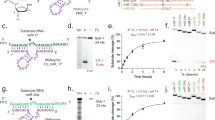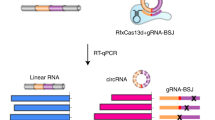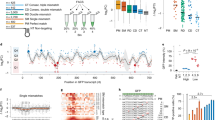Abstract
Single-stranded genomic DNA of recombinant M13 phages was tested as an antisense molecule and examined for its usefulness in high-throughput functional genomics. cDNA fragments of various genes (TNF-α, c-myc, c-myb, cdk2 and cdk4) were independently cloned into phagemid vectors. Using the life cycle of M13 bacteriophages, large circular (LC)-molecules, antisense to their respective genes, were prepared from the culture supernatant of bacterial transformants. LC-antisense molecules exhibited enhanced stability, target specificity and no need for target-site searches. High-throughput functional genomics was then attempted with an LC-antisense library, which was generated by using a phagemid vector that incorporated a unidirectional subtracted cDNA library derived from liver cancer tissue. We identified 56 genes involved in the growth of these cells. These results indicate that an antisense sequence as a part of single-stranded LC-genomic DNA of recombinant M13 phages exhibits effective antisense activity, and may have potential for high-throughput functional genomics.
This is a preview of subscription content, access via your institution
Access options
Subscribe to this journal
Receive 12 print issues and online access
$209.00 per year
only $17.42 per issue
Buy this article
- Purchase on Springer Link
- Instant access to full article PDF
Prices may be subject to local taxes which are calculated during checkout





Similar content being viewed by others
References
Dolnick, B.J. Antisense agents in cancer research and therapeutics. Cancer Invest. 9, 185–194 (1991).
Bennett, C.F. & Cowsert, L.M. Antisense oligonucleotides as a tool for gene functionalization and target validation. Biochim. Biophys. Acta 1489, 19–30 (1999).
Thompson, C.B., Challoner, P.B., Neiman, P.E. & Groudine, M. Levels of c-myc oncogene mRNA are invariant throughout the cell cycle. Nature 314, 363–366 (1985).
Melani, C., Rivoltini, L., Parmiani, G., Calabretta, B. & Colombo, M.P. Inhibition of proliferation by c-myb antisense oligodeoxynucleotides in colon adenocarcinoma cell lines that express c-myb. Cancer Res. 51, 2897–2901 (1991).
Anfossi, G., Gewirtz, A.M. & Calabretta, B. An oligomer complementary to c-myb-encoded mRNA inhibits proliferation of human myeloid leukemia cell lines. Proc. Natl. Acad. Sci. USA 86, 3379–3383 (1989).
Kamano, H. et al. Effects of the antisense v-myb expression on K562 human leukemia cell proliferation and differentiation. Leuk. Res. 14, 831–839 (1990).
Melotti, P. & Calabretta, B. Induction of hematopoietic commitment and erythromyeloid differentiation in embryonal stem cells constitutively expressing c-myb. Blood 87, 2221–2234 (1996).
Ferrari, S. et al. Differential effects of c-myb and c-fos antisense oligodeoxynucleotides on granulocytic differentiation of human myeloid leukemia HL60 cells. Cell Growth Differ. 1, 543–548 (1990).
Thaler, D.S., Liu, S. & Tombline, G. Extending the chemistry that supports genetic information transfer in vivo: phosphorothioate DNA, phosphorothioate RNA, 2′-O-methyl RNA, and methylphosphonate DNA. Proc. Natl. Acad. Sci. USA 93, 1352–1356 (1996).
Graham, M.J. et al. In vivo distribution and metabolism of a phosphorothioate oligonucleotide within rat liver after intravenous administration. J. Pharmacol. Exp. Ther. 286, 447–458 (1998).
Zhang, H. et al. Reduction of liver Fas expression by an antisense oligonucleotide protects mice from fulminant hepatitis. Nat. Biotechnol. 18, 862–867 (2000).
Roush, W. Antisense aims for a renaissance. Science 276, 1192–1193 (1997).
Tomita, N. et al. Transient decrease in high blood pressure by in vivo transfer of antisense oligodeoxynucleotides against rat angiotensinogen. Hypertension 26, 131–136 (1995).
Yacyshyn, B.R. et al. A placebo-controlled trial of ICAM-1 antisense oligonucleotide in the treatment of Crohn's disease. Gastroenterology 114, 1133–1142 (1998).
Moon, I.J. et al. Target site search and effective inhibition of leukaemic cell growth by a covalently multiple antisense oligonucleotide to c-myb. Biochem. J. 346, 295–303 (2000).
Moon, I.J. et al. Potent growth inhibition of leukemic cells by novel ribbon-type antisense oligonucleotides to c-myb. J. Biol. Chem. 275, 4647–4653 (2000).
Hieter, P. & Boguski, M. Functional genomics: it's all how you read It. Science 278, 601–602 (1997).
Lander, E.S. Array of hope. Nat. Genet. 21, 3–4 (1999).
Pandey, A. & Mann, M. Proteomics to study genes and genomes. Nature 405, 837–846 (2000).
Quackenbush, J. et al. The TIGR Gene Indices: analysis of gene transcript sequences in highly sampled eukaryotic species. Nucleic Acids Res. 29, 159–164 (2001).
Velculescu, V.E., Zhang, L., Vogelstein, B. & Kinzler, K.W. Serial analysis of gene expression. Science 270, 484–487 (1995).
Oien, K.A., Vass, J.K., Downie, I., Fullarton, G. & Keith, W.N. Profiling, comparison and validation of gene expression in gastric carcinoma and normal stomach. Oncogene 22, 4287–4300 (2003).
Prashar, Y. & Weissman, S.M. READS: a method for display of 3′-end fragments of restriction enzyme-digested cDNAs for analysis of differential gene expression. Methods Enzymol. 303, 258–272 (1999).
Gottschalk, A.R. et al. p27Kip1 is required for PTEN-induced G1 growth arrest. Cancer Res. 61, 2105–2111 (2001).
Zeng, J.Z., Wang, H.Y., Chen, Z.J., Ullrich, A. & Wu, M.C. Molecular cloning and characterization of a novel gene which is highly expressed in hepatocellular carcinoma. Oncogene 21, 4932–4943 (2002).
Ahn, J.D. et al. Inhibitory effects of novel AP-1 decoy oligodeoxynucleotides on vascular smooth muscle cell proliferation in vitro and neointimal formation in vivo. Circ. Res. 90, 1325–1332 (2002).
Suyama, E., Kawasaki, H., Nakajima, M. & Taira, K. Identification of genes involved in cell invasion by using a library of randomized hybrid ribozymes. Proc. Natl. Acad. Sci. USA 100, 5616–5621 (2003).
Caplen, N.J. RNAi as a gene therapy approach. Expert Opin. Biol. Ther. 3, 575–586 (2003).
Umans, L. et al. Targeted inactivation of the mouse alpha 2-macroglobulin gene. J. Biol. Chem. 270, 19778–19785 (1995).
Zimmermann, K. et al. Targeted disruption of the GAS41 gene encoding a putative transcription factor indicates that GAS41 is essential for cell viability. J. Biol. Chem. 277, 18626–18631 (2002).
Matsuda, M. et al. Abrogation of the Fc gamma receptor IIA-mediated phagocytic signal by stem-loop Syk antisense oligonucleotides. Mol. Biol. Cell 7, 1095–1106 (1996).
Vickers, T.A., Wyatt, J.R. & Freier, S.M. Effects of RNA secondary structure on cellular antisense activity. Nucleic Acids Res. 28, 1340–1347 (2000).
Smith, L., Andersen, K.B., Hovgaard, L. & Jaroszewski, J.W. Rational selection of antisense oligonucleotide sequences. Eur. J. Pharm. Sci. 11, 191–198 (2000).
Jupin, I. & Gronenborn, B. Abundant, easy and reproducible production of single-stranded DNA from phagemids using helper phage-infected competent cells. Nucleic Acids Res. 23, 535–536 (1995).
Mulligan, J.M., Campiani, G., Ramunno, A., Nacci, V. & Zisterer, D.M. Inhibition of G1 cyclin-dependent kinase activity during growth arrest of human astrocytoma cells by the pyrrolo-1,5-benzoxazepine, PBOX-21. Biochim. Biophys. Acta 1639, 43–52 (2003).
Yu, B., Lane, M.E., Pestell, R.G., Albanese, C. & Wadler, S. Down regulation of cyclin D1 alters cdk4- and cdk2-specific phosphorylation of retinoblastoma protein. Mol. Cell Biol. Res. Commun. 3, 352–359 (2000).
Diatchenko, L. et al. Suppression subtractive hybridization: a method for generating differentially regulated or tissue-specific cDNA probes and libraries. Proc. Natl. Acad. Sci. USA 93, 6025–6030 (1996).
Beuken, E., Vink, C. & Bruggeman, C.A. One-step procedure for screening recombinant plasmids by size. Biotechniques 24, 748–750 (1998).
Yonekura, H. et al. Antisense display, a method for functional gene screening: evaluation in a cell-free system and isolation of angiogenesis-related genes. Nucleic Acids Res. 27, 2591–2600 (1999).
Marcusson, E.G., Vincent, T.M., Hari, K.L., Chiang, M.Y. & Dean, N.M. Case study: use of a library of antisense inhibitors for gene functionalization and drug target validation. Drug Discov. Today: Targets 3, 117–122 (2004).
Chen, Y., Ji, Y.-J. & Conrad, C. Expression of ssDNA in mammalian cells. Biotechniques 34, 167–171 (2003).
Miyagishi, M. & Taira, K. Strategies for generation of a siRNA expression library directed against the human genome. Oligonucleotides 13, 325–333 (2003).
Shuda, M. et al. Enhanced expression of translation factor mRNAs in hepatocellular carcinoma. Anticancer Res. 20, 2489–2494 (2000).
Fan, B.L. et al. Cloning and identification of fibrinogen gamma polypeptide (FGG) gene differentially expressed in human hepatocellular carcinoma. Ai Zheng 23, 249–253 (2004).
De Backer, M.D. et al. An antisense-based functional genomics approach for identification of genes critical for growth of Candida albicans. Nat. Biotechnol. 19, 235–241 (2001).
Li, M.S., Li, P.F., Chen, Q., Du, G.G. & Li, G. Alpha-fetoprotein stimulated the expression of some oncogenes in human hepatocellular carcinoma Bel 7402 cells. World J. Gastroenterol. 10, 819–824 (2004).
Sambrook, J. & Russell, D.W. Plasmids and their usefulness in molecular cloning. in Molecular cloning: A laboratory manual 3rd edition (Cold Spring Harbor Laboratory Press, Cold Spring Harbor, New York, 2001).
Acknowledgements
This study was supported by generous grants of the CDRC of Korean Science & Engineering Foundation (research grant no. R01-2000-00138, R13-2002-028-01004-0), South Korea, and WelGENE Inc., a biotechnology company founded by Jong-Gu Park.
Author information
Authors and Affiliations
Corresponding author
Ethics declarations
Competing interests
The authors declare no competing financial interests.
Supplementary information
Supplementary Fig. 1
A schematic diagram for the construction of the phage genomic LC-antisense molecule for rat TNF-α (TNFα -LCAS). (PDF 113 kb)
Supplementary Fig. 2
Effect of cdk2-LCAS on the CDK2 protein level. (PDF 83 kb)
Supplementary Fig. 3
Real-time RT-PCR analysis of target gene expression in HeLa cells treated with cdk2- / cdk4-LCAS or cdk2 siRNA. (PDF 122 kb)
Supplementary Fig. 4
Effect of cdk4-LCAS on the CDK4 protein level. Western blot analysis was performed for the CDK4 expression in MCF7 cells 48 h after the treatments of cdk4-LCAS and cdk4-LCSE molecules. (PDF 73 kb)
Supplementary Fig. 5
A schematic diagram for the construction of a random-gene LC-antisense library. (PDF 99 kb)
Supplementary Table 1
List of cloning primers and sizes (PDF 72 kb)
Supplementary Table 2
List of RT-PCR primers (PDF 65 kb)
Supplementary Table 3
List of primers for real-time quantitative RT-PCR (PDF 58 kb)
Supplementary Table 4
List of PS end capped AS-oligos used for the antisense effect on WGSL11 expression. (PDF 46 kb)
Rights and permissions
About this article
Cite this article
Lee, YH., Moon, IJ., Hur, B. et al. Gene knockdown by large circular antisense for high-throughput functional genomics. Nat Biotechnol 23, 591–599 (2005). https://doi.org/10.1038/nbt1089
Received:
Accepted:
Published:
Issue Date:
DOI: https://doi.org/10.1038/nbt1089



